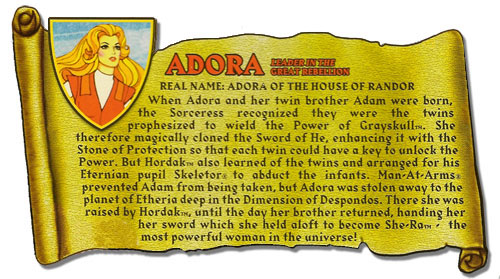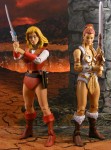 When Mattel began developing a toyline counterpart to Masters of the Universe geared toward girls, they didn’t stray too far from the formula that was working so well for He-Man and his pals. Eternia became Etheria, Skeletor became Hordak, the Sorceress became Lighthope, Battle Cat became Swift Wind, Orko became Cowl, He-Man became She-Ra, Princess of Power (POP), and Prince Adam became Adora.
When Mattel began developing a toyline counterpart to Masters of the Universe geared toward girls, they didn’t stray too far from the formula that was working so well for He-Man and his pals. Eternia became Etheria, Skeletor became Hordak, the Sorceress became Lighthope, Battle Cat became Swift Wind, Orko became Cowl, He-Man became She-Ra, Princess of Power (POP), and Prince Adam became Adora.
Unlike Prince Adam, Adora never got her own figure back in the 1980s. I’m not sure it was ever even in development (though I’m sure a better MOTU/POP historian than I would know, and could perhaps let us know in the comments below). Therefore POP fans have spent nearly a quarter of a century pining for an Adora figure. Mattel has proven their committment to fan desires with MOTUC several times already (He-Ro being the most obvious example), so it comes as no surprise that Adora is the line’s first foray into Etheria.
One interesting aspect of Adora’s story (which is really only implied in the bio below) is that she was actually on the bad guys’ team for most of her life, serving Hordak as his Force Captain. This plot twist is a bit weakened by the subplot that Hordak had Shadow Weaver cast a spell on Adora so she wouldn’t ever question the Horde’s methods, but it’s still more than we ever got about Prince Adam’s life before He-Man.

Packaging: Adora comes in the usual MOTUC packaging, though this time it’s branded with a bright POP sticker. I do like the way Mattel is both keeping a unique look to the packaging while setting off each unique sub-line via the large stickers.
The bio seems drawn almost entirely from the original POP cartoon, with little tweaking to fit the MOTUC canon, aside from the “Sword of He” cloning business (in the cartoon, the origin of the Sword of Protection–like that of the Power Sword–was a mystery, though both received multiple origins in the various comic books).
Design & Sculpt: As ToyGuru and the Horsemen have said many times, the mandate of Masters of the Universe Classics is to create the figures as if they were made in the 1980s but using modern-day standards of production, particularly in regards to articulation and accessories. Based on that description, Adora is a well-sculpted representative of the line. Like Teela, she stands a hair taller than He-Man, around 7″.
The Horsemen seem to have hewn as closely as possible to her cartoon look without making it identical (which seems to cross some potentially litigious line). She still has the same cute, pouty mouth, high, sharp cheekbones and flowing long hair. The hair suffers from softening, no doubt due to the production process, and ends up looking a bit like wet clay.
Like all MOTUC body sculpts, it’s not particularly complex or detailed, but it’s well executed by the Horsemen. The big controversy with Adora was the so-called “granny panties,” which in person seem much less like panties and much more like a small skirt or even the ends of a tunic. While it’s not accurate to the cartoon Adora, in person I think it looks fine and works perfectly well, and in fact, it allows for a much greater range of motion for Adora’s legs–just as the Four Horsemen intended.
Plastic & Paint: Adora’s hair is quite rubbery, a marked contrast to Teela or the Goddess. Her skirt is very pliable, allowing for the aforementioned great range of motion.
The paint applications leave a bit to be desired, however, particularly on the face. Between Teela, Adora and the upcoming Evil-lyn, there seems to be a noticeable, consistent drop in the quality of the face paint work from prototype to production on the female figures in MOTUC. There’s a certain lack of depth, of flatness, in the production paints that aren’t there in the prototypes.
My figure also has some annoying black bleed in her left eye (making her oddly reminiscent of actress Daniela Ruah, who plays Kensi on NCIS: Los Angeles and has a birthmark in one eye…it drove Dr. Mrs. Ghostal and I crazy for a while trying to figure out what was going on there).
There are also some small blotches of black paint on the left side of her face and her upper left arm, which I’ll discuss more in the Quality Control section.
Articulation: See the image on the right for a visual list of the articulation (trying something new–let me know what you think). The “rocker” ankles have a great range of motion, as do the legs via the ball jointed hips–moreso than either Teela or the Goddess, owing, I think, to the softness and design of the much-maligned “skirt.”
The head is still fairly poseable considering all that hair, and–perhaps because of the hair–there’s no bobblehead effect as seen on Teela and the Goddess.
Accessories: Adora comes with the Sword of Protection, a blaster, and a gunbelt for the blaster.
I like the blaster; it has a retro Buck Rogers look to it, and I always appreciate when they sculpt the hole in the trigger guard so it looks like the character is actually hold the gun properly. It fits well in the holster. The gunbelt is alleged to be removable via the buckle, but when I tried it the buckle seemed almost glued, so I stopped trying.
The sculpt of the Sword of Protection closely resembles the Filmation version of the weapon, rather than the one that came with the original She-Ra figure. This further confuses me as to where Mattel’s ownership rights end and Filmation’s begin. I appreciate the fact that the “jewel” is made from actual clear plastic and not just painted a shiny color, as we’ve seen on other figures.
However, the sword (which can be sheathed in a clip on her back) has two disappointments. First, the “jewel” is made from two halves glued on either side of the sword, rather than being one clear jewel you can see straight through, set it an empty hole in the sword–and the sword itself is monotone, rather than being two-toned like the Power Sword. This latter problem seems like it might just be a production oversight, but the prototype looked the same, so I guess this was a design decision.
Quality Control: While I’ve been fairly lucky with my MOTUC figures, that luck ran out here. Adora has two significant problems. First, there’s black gunk on her face and her upper left arm. I’m not sure what it is, but I tried to rub and scrape it off and neither seemed to work. How bothersome of an issue is this? Let me put it this way: since I was never that excited about Adora, I’m going to just keep her. But if my Trap Jaw comes like this next month, I might either send it back for a replacement or sell it and get another one.
Second, Adora’s left forearm is a bit warped, bowing out to the right. It looks awkward in some poses and isn’t as noticeable in others, but it’s annoying. A quick dip in boiling water, followed by re-setting the arm and dipping it in cold water might potentially fix the issue, but I haven’t tried it yet.
Overall: The QC issues, the lack of a two-toned sword, and the relatively minimal accessories compared to other figures in the line–combined with my general lack of enthusiasm for the character–make Adora a rather average addition to my MOTUC collection.
Adora was the first MOTUC figure I was not excited about. I have zero nostalgic memories of She-Ra, my He-Man period of interest having ended roughly around the time the She-Ra cartoon started. That said, I can certainly understand this figure’s appeal to POP fans who have been waiting for 25 years for an Adora figure. And so, bearing in mind that my “overall” ratings are subjective, if you like the character you can add as many ravens as you want.
[raven 3]









